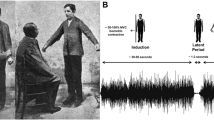Abstract
A closed solution of the integral equation obtained by N. Rashevsky, with the assumption that the inhibitory influence between centers is a constant, i.e., independent of the distance apart, is obtained. Furthermore, a more general kernel, representing a variable inhibitory influence, which in our case is a monotonic (increasing or decreasing) function of the distance between centers, is introduced. The resulting integral equation is solved and some properties of the solution discussed.
Similar content being viewed by others
References
N. Rashevsky, “Mathematical Biophysics and Psychology,”Psychometrika, 1936,1, pp. 1–26.
N. Rashevsky, “Mathematical Biophysics of Delayed Reflexes in Connection with the Theory of Error Elimination.”Psychometrika, 1936,1, 265–273. We shall refer to this paper as II.
In fact ifK is expressible as a sum of finite number of such products. See,e. g., Courant-Hilbert,Methoden der Mathematischen Physik, pp. 99–101, 1931 (Berlin).
Author information
Authors and Affiliations
Rights and permissions
About this article
Cite this article
Householder, A.S., Amelotti, E. Some aspects of Rashevsky's theory of delayed reflexes. Psychometrika 2, 255–262 (1937). https://doi.org/10.1007/BF02287897
Issue Date:
DOI: https://doi.org/10.1007/BF02287897




